Overview
The article delineates ten significant benefits of automated chain of title software for title researchers, with a strong emphasis on enhancements in efficiency, accuracy, cost savings, and collaboration. These advantages arise from the software's capability to streamline processes, mitigate errors, and foster improved communication. Consequently, this empowers professionals to concentrate on high-value tasks, thereby amplifying their overall productivity in real estate transactions.
Introduction
In the realm of title research, efficiency and accuracy are paramount. However, traditional methods often leave professionals grappling with time-consuming tasks and high error rates. Enter Parse AI, a groundbreaking solution that leverages advanced machine learning and optical character recognition to revolutionize the processing of title documents. By automating the extraction of essential data, this innovative technology not only accelerates the title search process but also minimizes human errors that can lead to costly mistakes.
As the landscape of real estate evolves, the demand for smarter, more efficient tools becomes increasingly critical. This article delves into the myriad benefits of automated title research software, exploring how it enhances productivity, accuracy, and collaboration while driving significant cost savings for title companies.
Parse AI: Streamline Title Research with Automated Document Processing
employs alongside optical character recognition (OCR) to automate the extraction of . This cutting-edge technology enables researchers to efficiently process vast amounts of documents, to manual data entry and analysis.
For example, Arbor Realty Trust experienced a notable enhancement in processing efficiency, achieving over a 95% straight-through processing rate after implementing —an impressive leap from their prior 20% error rate in data extraction from elevation certificates.
By using to automate these repetitive tasks, Parse AI empowers professionals to focus on higher-value activities, such as data interpretation and making informed decisions regarding property ownership. The integration of is vital for optimal OCR performance, ensuring both accuracy and reliability in data extraction.
As the competitive landscape in the Intelligent Document Processing (IDP) sector evolves, with specialized providers and large corporations enhancing their services, advancements in machine learning continue to elevate research capabilities. This competition fosters rapid innovation, equipping with the necessary tools to navigate their workflows more efficiently.
Furthermore, as highlighted by Vertikal, collaborating with advanced document processing solutions can yield significant cost savings and , underscoring the like Parse AI.
Increased Efficiency: Reduce Time Spent on Title Searches
significantly decreases the time needed for ownership searches, . Manual methods often necessitate extensive document review, which can extend over days or even weeks. In contrast, enable researchers to complete searches in a fraction of that time, often achieving reductions of up to 70%.
For instance, while manual searches can take an average of 10 days, . This efficiency empowers professionals to manage multiple cases simultaneously, ensuring they can meet tight deadlines without sacrificing quality.
Furthermore, is vital in the property search process, and while enhancing efficiency. Success stories abound, with many users reporting , report generation, and client communication.
One notable case study, 'Streamlined Workflow in ,' demonstrates how the software combines multiple stages of the search procedure into a single tool, minimizing mistakes and duplication. Consequently, the automation of document searches not only accelerates decision-making but also greatly enhances customer satisfaction.
As Emma Grace, an expert in technology and entrepreneurship, wisely remarks, 'Act now—your quicker, more efficient search process is just a click away!
Enhanced Accuracy: Minimize Errors in Title Documentation
Automated research software significantly enhances accuracy by , which is often a source of errors in manual data entry. excels in consistently extracting and analyzing data, enabling researchers to rely on accurate information that is crucial for informed decision-making in real estate transactions.
Research indicates that automated systems can by up to 30%, underscoring the in this domain. Furthermore, industry experts emphasize that minimizing errors not only but also fosters greater confidence in the data used for critical transactions.
Organizations that utilize report a , with some achieving up to 25% fewer inconsistencies in document titles. This shift towards automation, specifically through automated chain of title software, enhances the reliability of research and contributes to overall efficiency, allowing professionals to of their work rather than becoming bogged down by manual data entry tasks.
As Rita Lazar-Tippe, Chief Digital Officer, remarked, ' were too custom for typical LOS tools, but Feathery was able to meet those standards while allowing us to launch 5x faster than building in house.' This statement underscores the importance of tailored solutions in achieving accuracy and efficiency.
Additionally, automated systems for equipment maintenance have been shown to improve uptime by 20%, further illustrating the benefits of automation across various sectors.
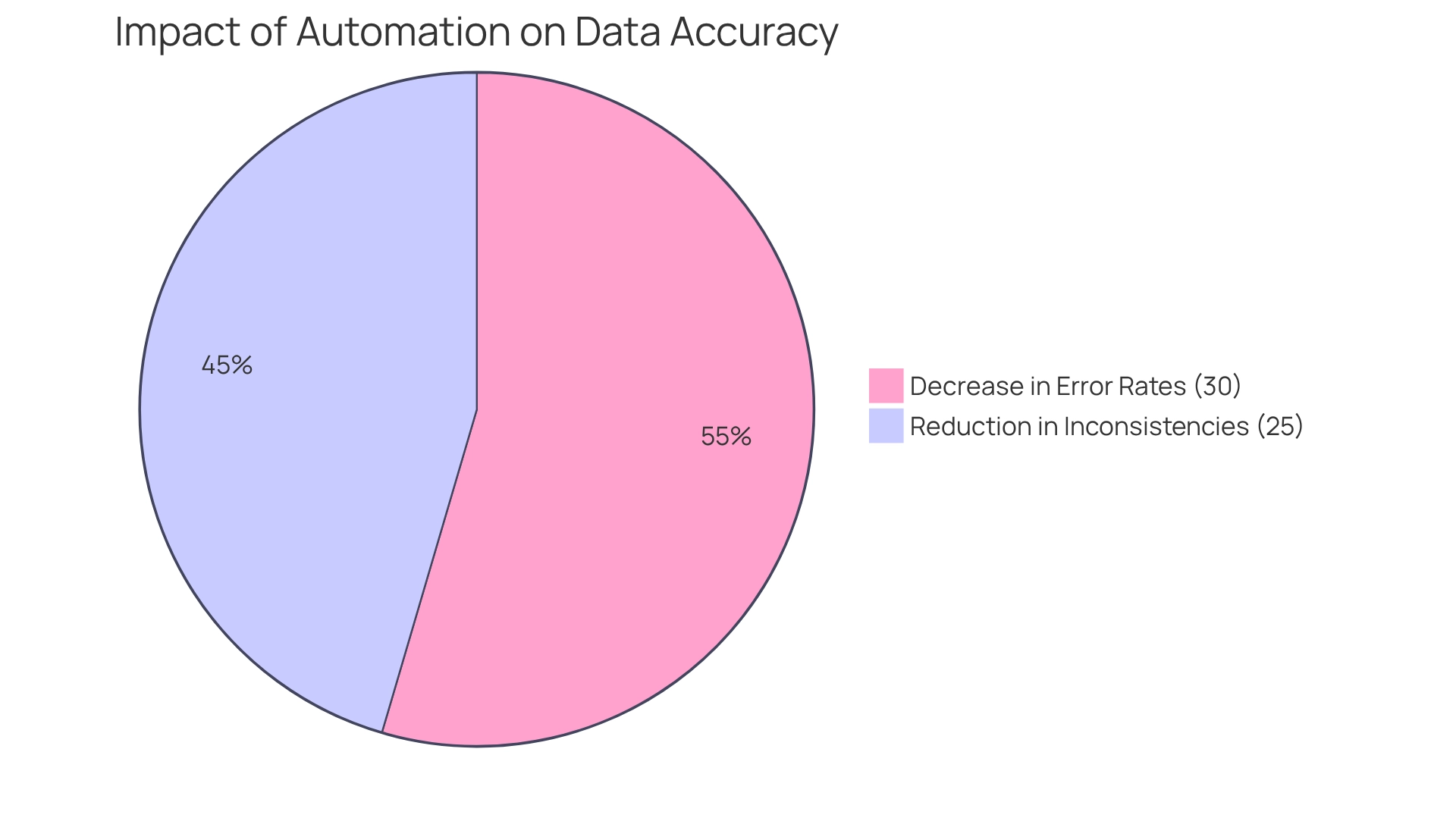
Cost Savings: Lower Operational Expenses with Automation
The implementation of offers substantial cost reductions for firms engaged in property management. By and significantly minimizing errors, firms can effectively reduce their operational expenses. Automation not only decreases the necessity for extensive staffing but also allows companies to reallocate resources toward strategic initiatives, thereby .
In fact, businesses that adopt automation report , primarily through error reduction and efficiency gains. Furthermore, over , making clear. This trend is underscored by the , which highlights the growing significance of automation within the industry.
Consequently, property firms can focus on more valuable activities, fostering growth and innovation while maintaining a competitive edge in the market. Additionally, 51% of automation initiatives aim to enhance employee efficiency, further reinforcing the case for automation's benefits in boosting productivity within organizations.
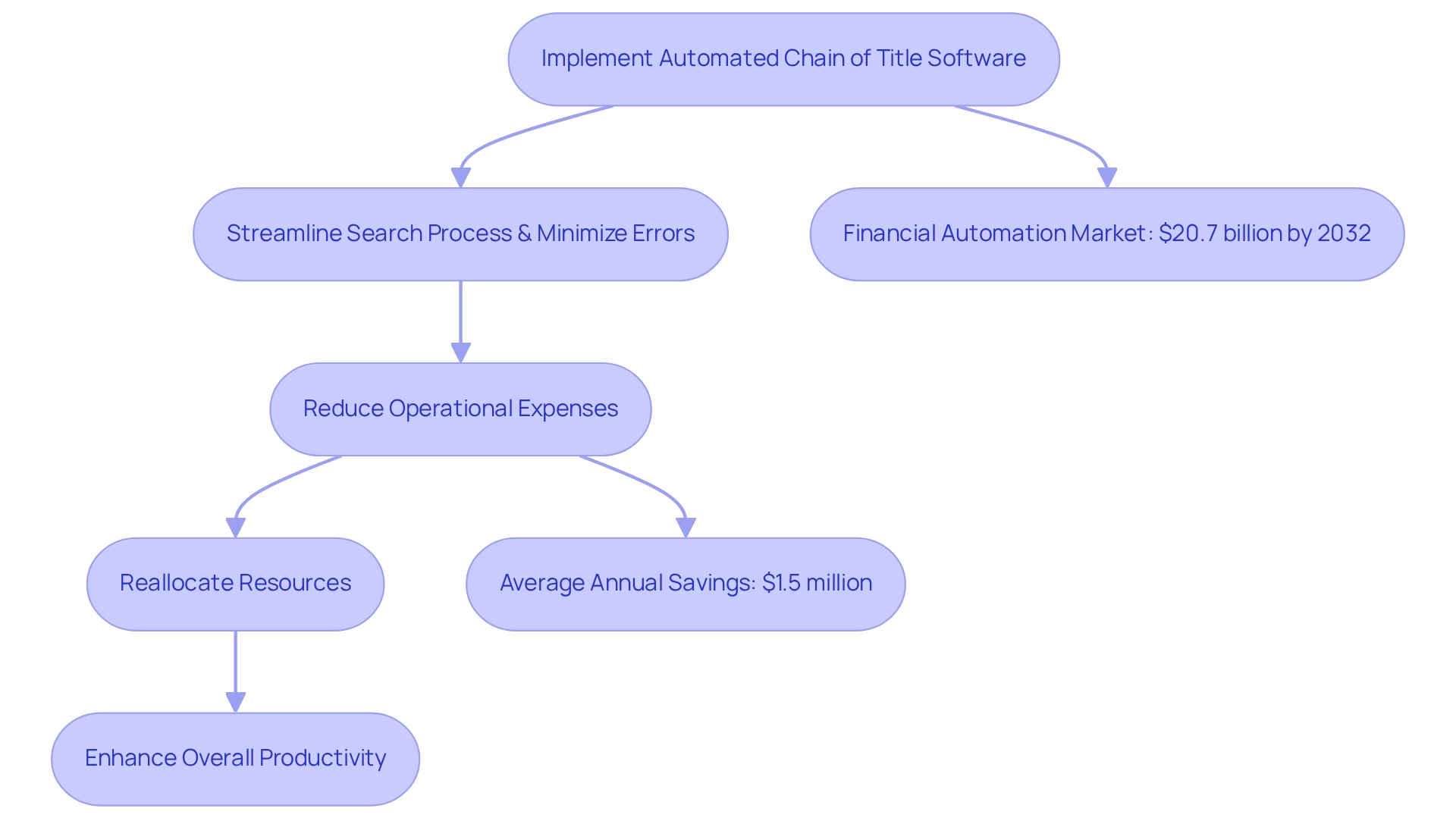
Simplified Legal Language: Navigate Complex Title Documents Easily
Automated systems, such as Parse AI, are essential in demystifying the often found in ownership documents. By offering and highlighting crucial information, these tools empower researchers to navigate intricate legal jargon with ease. This simplification not only accelerates the but also significantly , enabling professionals to make .
Research indicates that can reduce decision-making time by up to 30%, showcasing the efficiency improvements that brings to property examination workflows. Furthermore, the capability of these systems to provide real-time streaming of simplified text as documents are processed allows investigators immediate access to critical information, further streamlining their workflow.
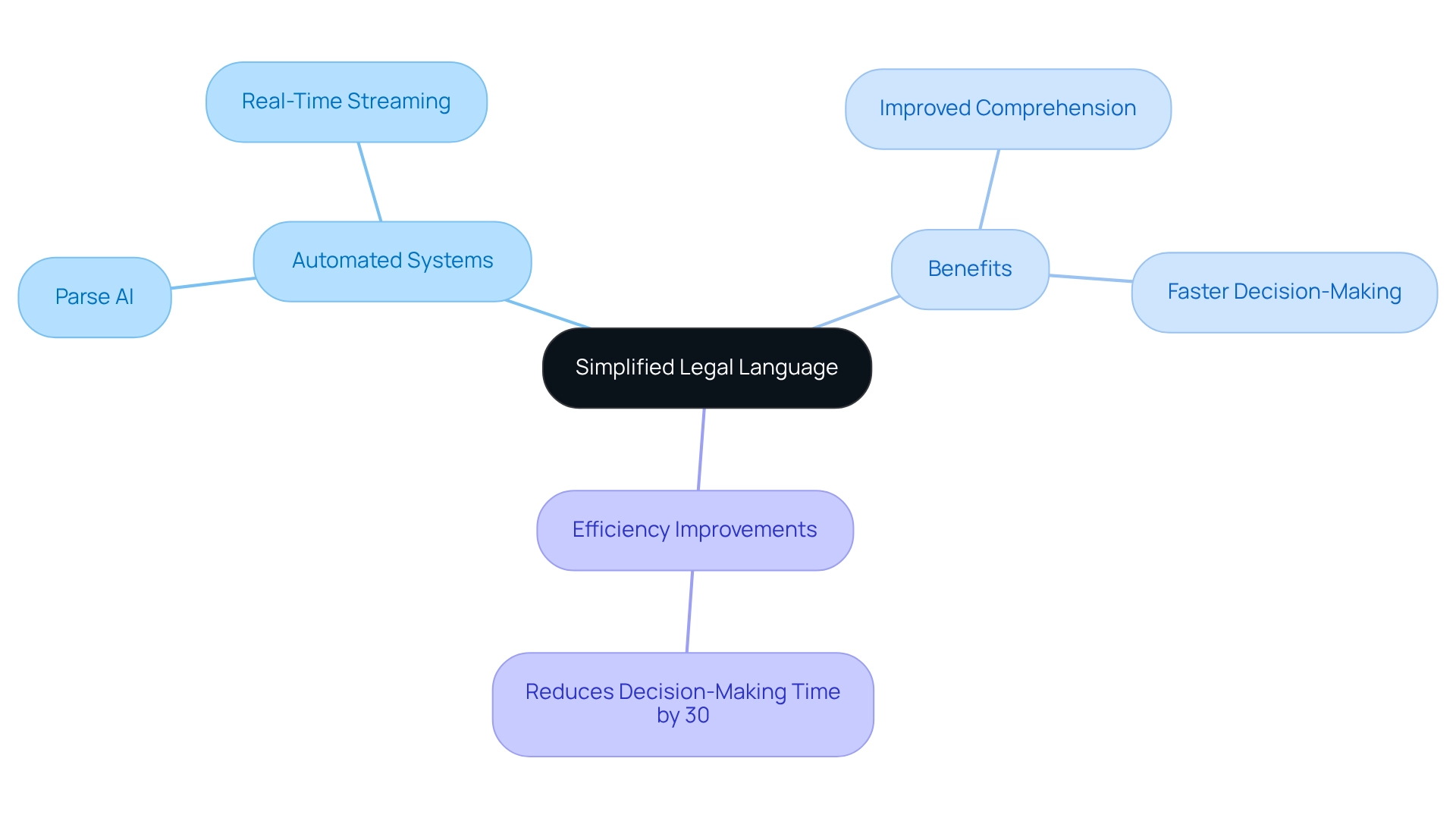
Improved Collaboration: Foster Teamwork with Shared Digital Tools
Automated chain of title software significantly enhances teamwork among group members by providing that facilitate seamless communication and information exchange. A centralized platform allows researchers to access and update information effortlessly, ensuring alignment among all team members. This not only but also minimizes the risk of miscommunication.
In fact, statistics reveal that 66% of clients have switched to competitors due to , underscoring the critical need for . As highlighted in recent discussions, fostering open communication and transparency is essential to developing a robust collaboration strategy.
Furthermore, a study indicates that in-office employees dedicate 43% of their time to collaboration, while remote employees allocate 27% to virtual collaboration, illustrating the varying dynamics of . By utilizing automated chain of title software, research teams can enhance their cooperation, ultimately leading to increased productivity and improved service provision.
To implement these shared digital tools effectively, consider establishing regular check-ins and utilizing collaborative platforms that allow for real-time updates and feedback.
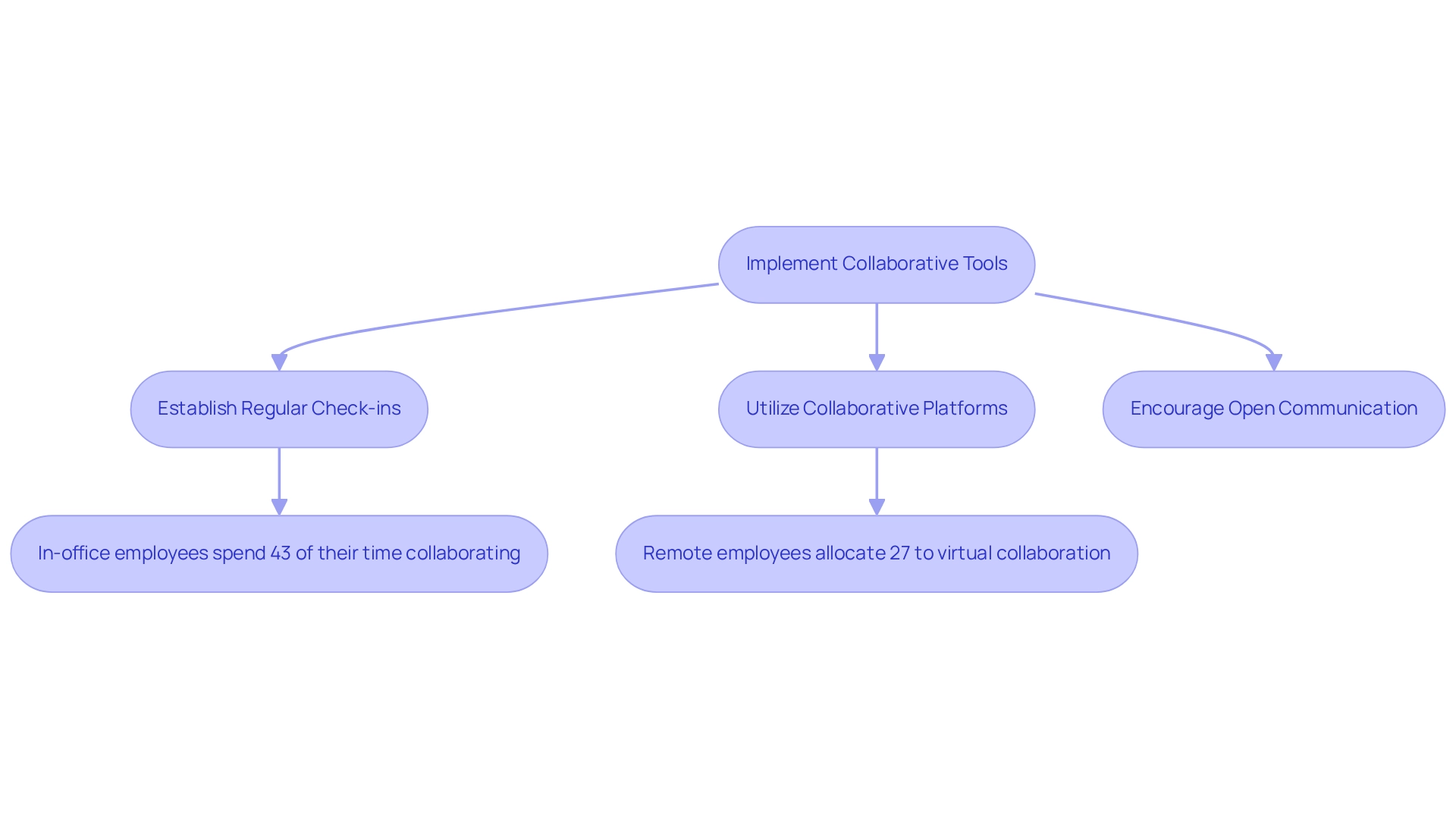
Scalability: Adapt to Varying Workloads with Ease
A significant benefit of lies in its inherent scalability. Title companies can seamlessly adjust to growth or fluctuations in workload, ensuring they effectively meet changing demands. During periods of heightened document searches, these systems manage the influx without compromising quality. Conversely, when workloads decrease, automated solutions facilitate a streamlined approach, maintaining operational efficiency. This adaptability is crucial, as research indicates that , necessitating a .
For instance, statistics reveal that naming firms can experience during peak seasons. By leveraging automation, property companies can adeptly manage these variations, ensuring they remain agile and competitive in a dynamic market. Furthermore, as emphasized by industry specialists, understanding the distinct requirements of various consumer segments is essential for companies to tailor their services accordingly.
A case study involving a prominent utility provider illustrated how cloud-based solutions , enabling them to accommodate significant user loads while improving response times by 30%. This exemplifies the in related contexts, thereby strengthening the case for automated chain of title software in the realm of document analysis.

Seamless Integration: Connect with Existing Title Research Systems
Parse AI is engineered for seamless integration with existing documentation systems, empowering organizations to embrace automation without disrupting established workflows. This compatibility allows specialists to utilize familiar tools while reaping the benefits of . The integration process is intentionally straightforward, significantly minimizing downtime and boosting productivity.
Statistics indicate that by 2024, automation will oversee , underscoring the importance of incorporating into research. User feedback consistently highlights the ease of this integration, with many specialists noting that the transition to automated systems has optimized their workflows and improved overall efficiency.
A recent case study titled "How AI and Machine Learning Are Changing the Future of Work" exemplifies how AI technologies can drastically alleviate employee workloads, enabling them to concentrate on high-impact strategic initiatives.
Furthermore, Salesforce forecasts that will expand at a compound annual growth rate exceeding 14.2% from 2024 to 2032, reaching $20.7 billion by 2032, further emphasizing the in enhancing productivity across sectors.
Expert insights reveal that the key to lies in aligning new technologies with existing workflows, ensuring that professionals can focus on high-impact tasks while automated systems manage routine operations.
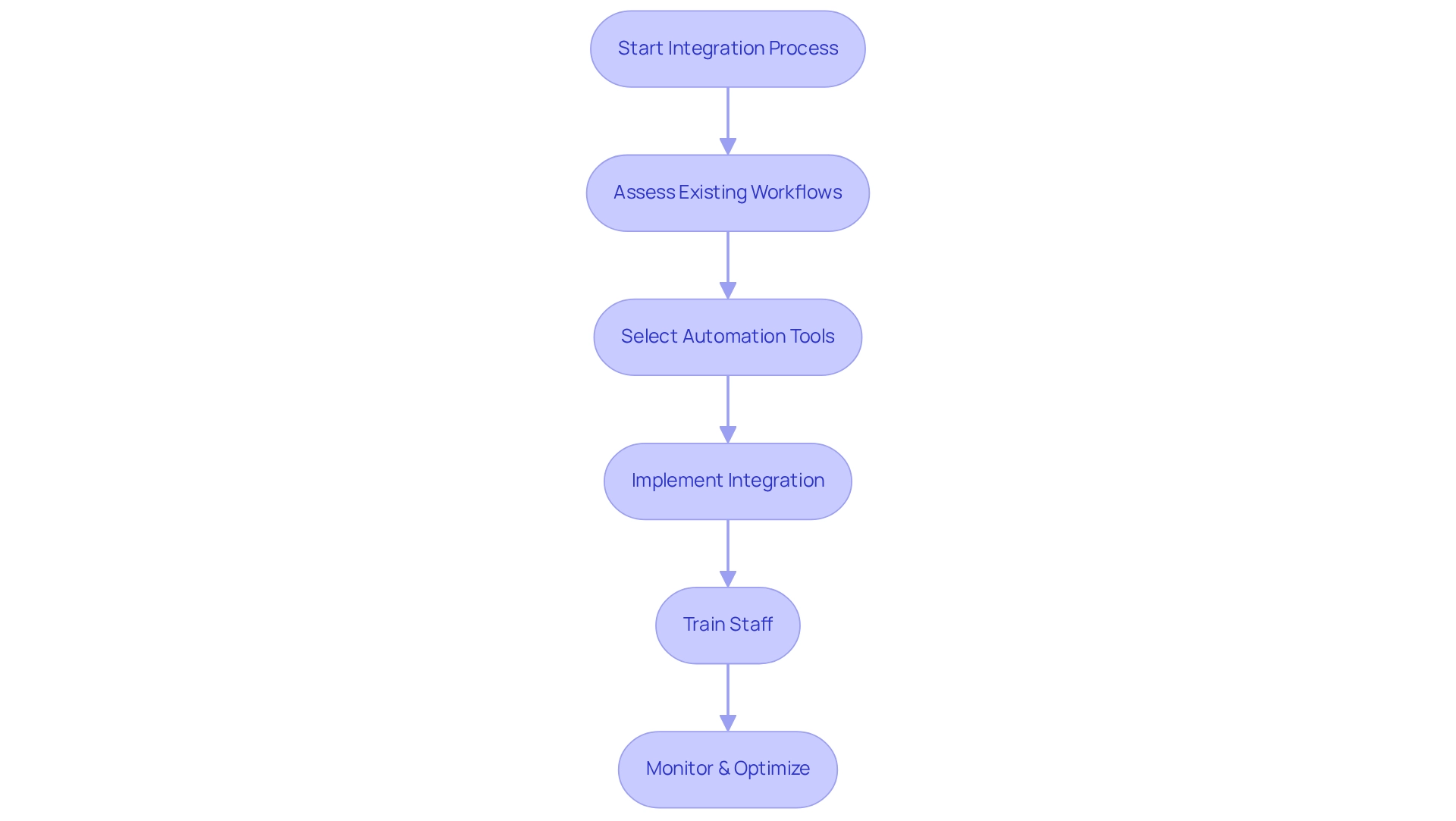
Continuous Improvement: Stay Updated with Evolving Title Research Needs
Automated research applications, such as Parse AI, are developed with a strong focus on ongoing enhancement. As the real estate landscape evolves, the demands placed on property examiners also adapt. This application receives regular updates, incorporating new features and improvements derived from user feedback and emerging industry trends. Such a not only equips investigators with but also and responsiveness within organizations.
Statistics indicate that cultivating a necessitates involvement from all staff, which is crucial for the growth and efficiency of research tools. Collective input from users directly influences the program's development, ensuring it meets the specific needs of research specialists.
Furthermore, case studies, such as ' vs. Traditional Methods,' illustrate that continuous improvement software, which adopts an iterative and incremental approach, significantly outperforms traditional linear methods by prioritizing feedback, collaboration, and data-driven decision-making. This adaptability allows to effectively respond to the evolving demands of documentation, ensuring that professionals remain at the forefront of their field.
As highlighted by Team Kissflow, 50% of business leaders plan to implement automated chain of title software to automate additional repetitive tasks within their organizations, underscoring the broader trend of automation relevant to research on titles. The distinct value of Parse AI lies in its ability to consistently enhance and adapt, making it an essential resource for professionals navigating a perpetually changing industry.

User-Friendly Interface: Enhance Usability for Title Researchers
Parse AI's is meticulously crafted for individuals conducting studies, enabling even those with limited technical skills to navigate the software effortlessly. The intuitive design features and straightforward navigation pathways significantly elevate the user experience, allowing researchers to quickly access critical information. This emphasis on usability not only enhances operational efficiency but also promotes greater adoption of technology across title companies. As Marcos Nähr, , asserts, 'This focus on has resulted in ,' underscoring the pivotal role of usability in driving user satisfaction and adoption rates.
Industry trends indicate that effective usability in applications correlates with , measurable through metrics like Daily Active Users (DAU) and Monthly Active Users (MAU). Title researchers have observed that diminish the learning curve, facilitating the integration of automated tools into their daily tasks. A pertinent case study on a project management tool demonstrated that advanced UX principles led to a to new workflows, resulting in a twofold increase in productivity. This illustrates the transformative power of user-friendly design in document analysis tools.
The positive feedback from users further emphasizes the importance of prioritizing usability in application design, as it directly correlates with enhanced efficiency and satisfaction in research processes. Moreover, measuring user adoption can guide a proactive product roadmap, ensuring that software continues to address the evolving needs of title researchers.
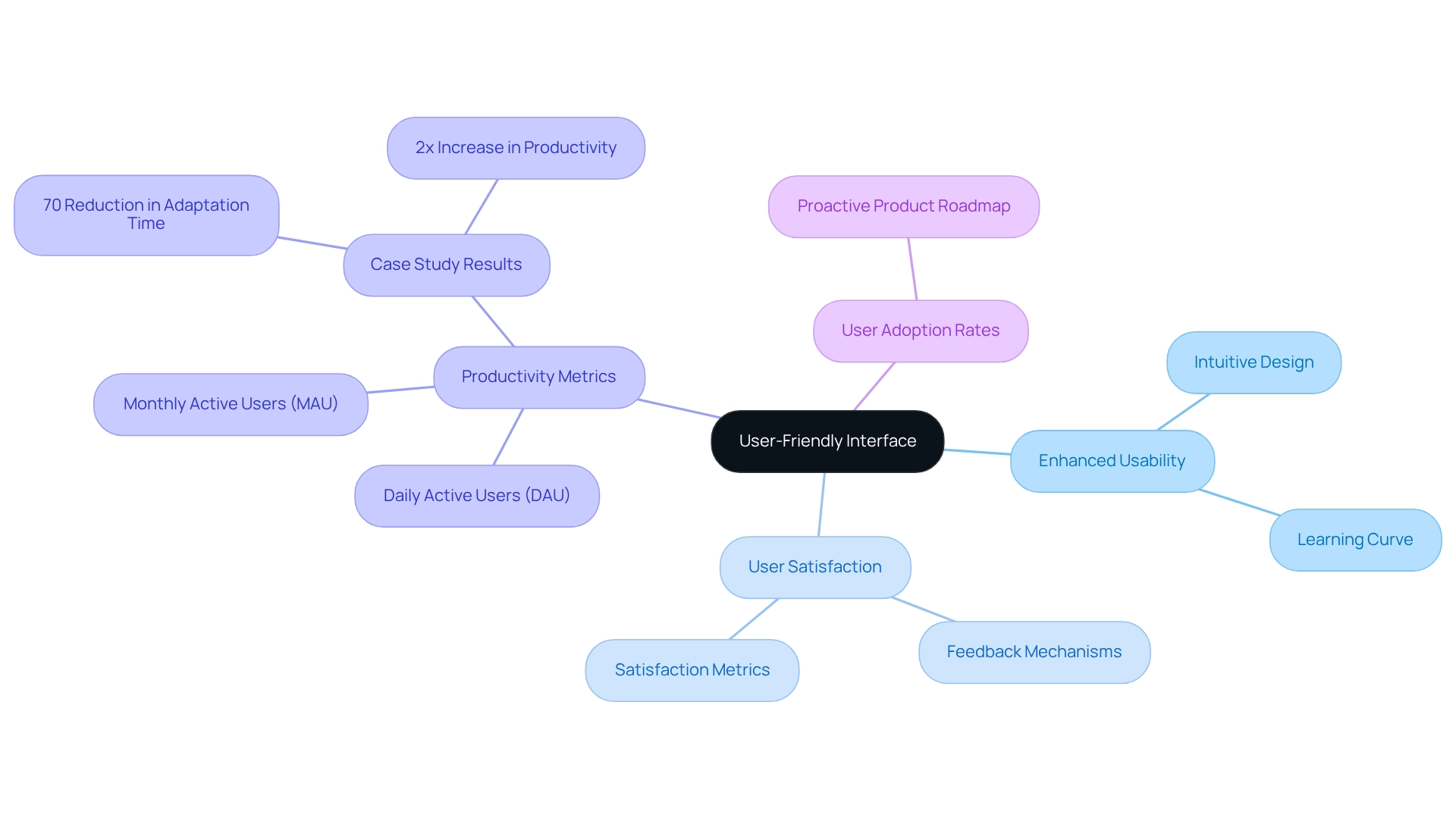
Conclusion
Transforming title research through automation is not merely a trend; it is an essential requirement for the evolving real estate landscape. The integration of Parse AI's advanced machine learning and optical character recognition technologies significantly enhances efficiency, accuracy, and collaboration within title companies. By automating data extraction and streamlining workflows, professionals achieve remarkable reductions in processing time and error rates, driving productivity and cost savings.
The advantages of automated title research software extend well beyond efficiency. With enhanced accuracy and simplified legal language, title researchers are empowered to make informed decisions swiftly, fostering greater confidence in transactions. Moreover, the scalability of these solutions allows companies to adapt seamlessly to varying workloads, ensuring they remain competitive in a dynamic market.
Furthermore, the user-friendly interface and seamless integration with existing systems facilitate a smooth transition to automation, enhancing overall usability and encouraging widespread adoption. As the industry continues to evolve, the commitment to continuous improvement ensures that automated solutions like Parse AI remain at the forefront, meeting the ever-changing needs of title researchers.
In conclusion, embracing automation is vital for title companies striving to thrive in an increasingly competitive environment. By leveraging technologies that prioritize efficiency, accuracy, and collaboration, the future of title research is not only promising but also transformative, paving the way for smarter, more effective practices in the industry.
Frequently Asked Questions
What technology does Parse AI use to automate data extraction from documents?
Parse AI employs advanced machine learning algorithms alongside optical character recognition (OCR) to automate the extraction of critical data from document titles.
How does Parse AI improve processing efficiency for document handling?
By using advanced document processing solutions, Parse AI has helped organizations like Arbor Realty Trust achieve over a 95% straight-through processing rate, significantly improving efficiency from a previous 20% error rate in data extraction.
What benefits does automated chain of title software provide?
Automated chain of title software significantly reduces the time needed for ownership searches, transforming a traditionally labor-intensive process and allowing researchers to complete searches in a fraction of the time, often achieving reductions of up to 70%.
How does automation affect the time taken for ownership searches?
While manual searches can take an average of 10 days, automated searches can often be completed in just 3 days, enabling professionals to manage multiple cases simultaneously.
What role does adherence to regulations play in the automated property search process?
Automated systems assist in upholding local, state, and federal regulations during the property search process while enhancing efficiency.
How does automated research software impact accuracy in data handling?
Automated research software significantly enhances accuracy by minimizing human intervention, which is a common source of errors in manual data entry. Parse AI can decrease error rates in documentation by up to 30%.
What improvements in accuracy have organizations reported after using automated chain of title software?
Organizations utilizing automated chain of title software report achieving up to 25% fewer inconsistencies in document titles, enhancing the reliability of research.
What are some additional benefits of automation in various sectors?
Beyond document processing, automated systems for equipment maintenance have been shown to improve uptime by 20%, illustrating the broader benefits of automation across different sectors.




